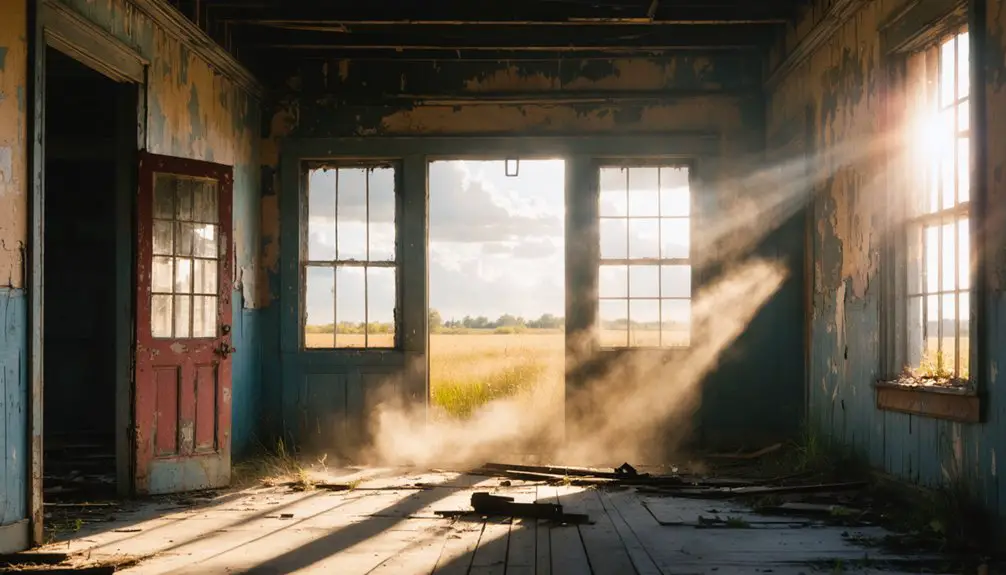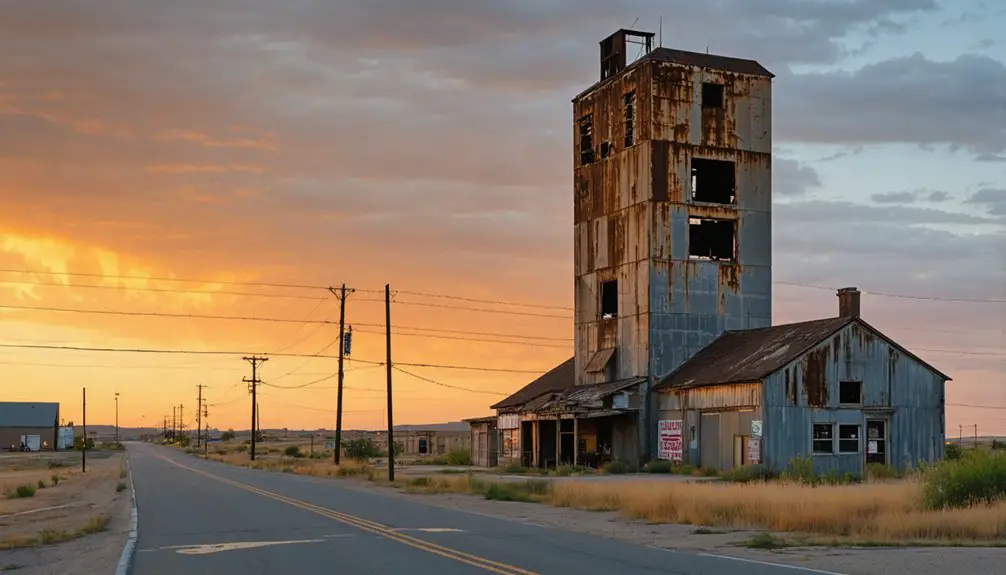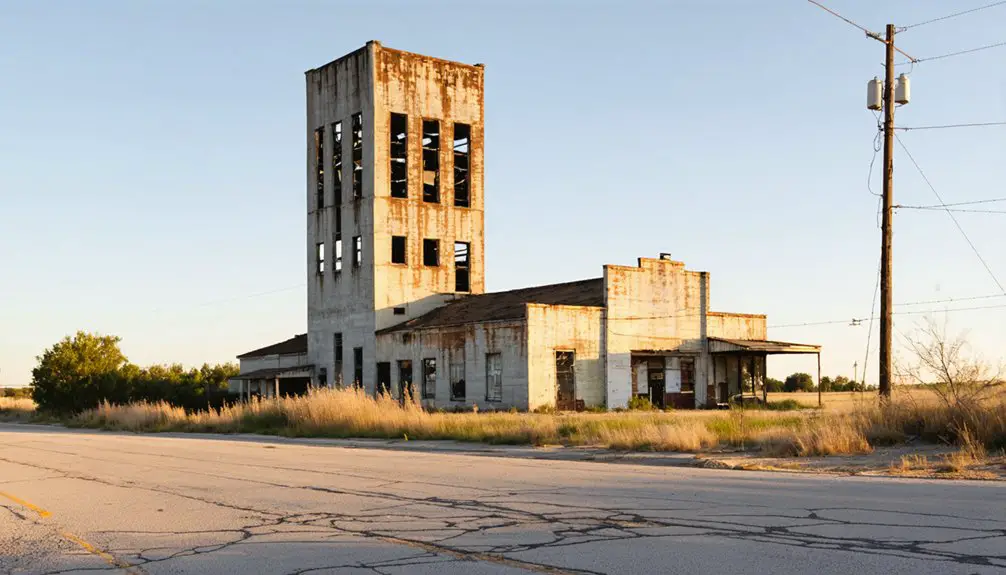You’ll find Byron, Oklahoma among America’s most evocative ghost towns, where abandoned buildings and weathered foundations tell the story of a once-thriving railroad community. After the Kansas City, Mexico and Orient Railway arrived in 1902, Byron flourished with banks, general stores, and grain elevators, reaching a peak population of 286. The Great Depression and Dust Bowl devastated the town in the 1930s, leaving behind silent streets that reveal Oklahoma’s fascinating frontier heritage.
Key Takeaways
- Byron flourished from 1902-1909 with 286 residents before declining due to the Great Depression and Dust Bowl in the 1930s.
- The town’s development began with the Kansas City, Mexico and Orient Railway in 1902, establishing banks, stores, and grain elevators.
- The collapse of farming income during the Depression forced residents to abandon farms, leading to widespread business closures.
- Today, Byron exists as a ghost town with abandoned structures and foundations scattered across its former townsite.
- The site attracts history enthusiasts and photographers interested in exploring Oklahoma’s rural past through its deteriorating buildings.
The Birth of a Railroad Town

When Byron, Oklahoma first appeared in an 1898 state gazetteer, the town’s prospects remained limited until the arrival of the Kansas City, Mexico and Orient Railway in 1902.
You’ll find the town’s true birth emerged through several key developments that shaped its railroad significance. After gaining postal designation in April 1898, W.C. Edwards purchased land for a new townsite in 1901, sparking the community’s strategic relocation. The town quickly established essential businesses, including a bank, meat market, and lumberyard, strengthening its community identity. Similar to the exclusive railroad rights granted to the Cherokee Nation in 1866, Byron’s railroad access proved vital to its development.
The railroad’s completion in October 1902 transformed Byron into a bustling hub. You can imagine the excitement as locals celebrated with a massive bonfire, welcoming railroad workers. By 1909, the town had reached its peak of 286 residents.
As railroad tracks reached Byron in 1902, townspeople lit the October sky with celebration fires, marking their new future.
The simultaneous construction of a grain elevator positioned Byron perfectly for agricultural shipping, cementing its place as an important railroad town.
Agricultural Roots and Early Growth
Although Byron began as a modest rural settlement in 1898, its agricultural foundation quickly took root in the fertile lands of what would become Alfalfa County.
Much like Romantic poet Byron who inherited his title at a young age, the town inherited a legacy of agricultural prosperity early in its development. The Great Depression’s price drops severely impacted the farming community and marked the beginning of Byron’s decline. You’d have found farming techniques centered on wheat and alfalfa production, with the town’s strategic location near State Highways 8 and 11 facilitating market access. The community’s resilience showed in its rapid development of agricultural infrastructure, including a crucial grain elevator in 1902.
- Local blacksmiths kept farming equipment and horses in prime condition
- Two general stores and hardware shops supplied essential farming needs
- A flour mill processed local grain harvests efficiently
- The community supported two churches where farming families gathered
Byron’s population grew to 286 by 1909, reflecting the success of its agricultural economy and community spirit.
Peak Years of Prosperity
During Byron’s golden age from 1902 to 1909, the arrival of the Kansas City, Mexico and Orient railroad transformed this modest farming settlement into a bustling commercial hub.
You’d have found a thriving town of 286 residents, with two newspapers keeping you informed of community events and civic engagement. The Byron Republican and Byron Promoter chronicled the prosperity of local businesses, including the Byron State Bank, three general stores, and two hardware stores.
You could’ve shipped your grain and livestock directly from town, thanks to the new elevator and rail connection. Just as users on Wikipedia need proper disambiguation pages to find their way, Byron’s rail connections helped residents navigate trade routes effectively.
The Methodist and Christian churches anchored spiritual life, while the skating rink offered entertainment.
Local government, schools, and merchants created a self-sustaining community where farmers and merchants prospered together.
The Great Depression’s Impact
Byron’s vibrant agricultural economy came to a grinding halt when the Great Depression struck Oklahoma in 1930, as plummeting farm incomes and crop failures devastated the region’s tenant farmers.
You’d have seen the town’s merchants struggle as their farming customers lost 64% of their income, leading to a cascade of local business closures.
The combination of economic collapse and the emerging Dust Bowl forced many of Byron’s residents to abandon their farms and businesses, seeking survival elsewhere as the town’s commercial infrastructure crumbled. Like many oil-boom towns that flourished in the 1920s, Byron’s prosperity evaporated during the harsh economic downturn. Many residents moved to urban areas as part of the widespread relocation pattern seen across Oklahoma’s rural communities.
Agricultural Market Collapse
When farm product prices plummeted in 1929-1930, Byron’s agricultural community faced devastating economic consequences alongside the broader 10-30% decline in U.S. economic output.
The farm price volatility crushed local farmers’ economic resilience, as crop prices fell dramatically across the Midwest region. Cotton prices experienced a particularly harsh 39% price drop from late 1929 to mid-1930. The severe decline in prices led to reduced farmer spending that rippled through the entire local economy.
You’ll understand the severity of Byron’s situation through these key impacts:
- Farm mortgage debt reached a crushing 190% of net farm income by 1930
- Local retail sales collapsed as farmers couldn’t afford basic goods
- Rural banks failed when farmers couldn’t repay loans
- Falling international demand and competition from Argentina and Australia further depressed prices
The combination of overproduction, weak overseas markets, and mounting debts created a perfect storm that would forever change Byron’s farming community.
Many farmers lost everything they’d built, unable to recover from the price collapse.
Local Business Closures
As the Great Depression tightened its grip on rural Oklahoma, Byron’s business district suffered a cascade of closures that would permanently alter the town’s economic landscape.
You’d have witnessed general stores, hardware shops, and blacksmiths shuttering their doors as consumer spending plummeted.
The town’s business resilience was severely tested when bank closures cut off crucial loans and financial liquidity.
Many residents, like the McIntyre family who lost their home to bank foreclosures, were forced to rely on community support to survive.
Abandonment and Decline

The steady abandonment of Byron tracked closely with broader economic shifts that plagued many small Oklahoma towns during the twentieth century.
Population shifts accelerated as young residents sought opportunities elsewhere, leaving behind an aging community struggling with economic vulnerabilities.
You’ll find that Byron’s decline mirrors a classic pattern of ghost town formation, where the loss of essential transportation connections and business closures created a downward spiral.
- Transportation changes, including shifts in railroad routes and highway development, severely limited Byron’s access to trade.
- Loss of schools, post offices, and community institutions eroded social fabric.
- Agricultural challenges and market changes weakened the town’s economic foundation.
- Exodus of working-age residents led to demographic imbalance, making recovery increasingly difficult.
Present-Day Ghost Town Legacy
Standing as a tribute to Oklahoma’s evolving landscape, Byron’s present-day remnants offer visitors a stark glimpse into the state’s rural past.
You’ll find abandoned structures and foundations scattered across what was once a thriving community of 286 residents. Today, this ghost town‘s cultural significance lives on through its connection to rancher Nathan H. Byars and its role in Oklahoma’s territorial development.
While you mightn’t find many historical markers or maintained infrastructure, Byron’s deteriorating buildings and quiet streets tell a compelling story of boom-and-bust cycles in the American heartland.
Time and neglect have transformed Byron into silent testament of Oklahoma’s economic tides, where empty buildings whisper stories of frontier dreams.
The site draws ghost town enthusiasts and photographers, though you’ll need to navigate carefully around aging structures. The surrounding farmland and pastures have reclaimed much of what was once a bustling agricultural center in the Oklahoma Panhandle.
Frequently Asked Questions
Are There Any Reported Ghost Sightings or Paranormal Activity in Byron?
You won’t find documented ghost encounters or eerie legends specific to Byron in historical records. While the town’s abandoned buildings create an atmospheric setting, there’s no verified paranormal activity reported here.
What Happened to Byron Spurrier After the Town Was Named?
Based on historical records, you won’t find further facts about Byron Spurrier’s later life. His legacy persists primarily through the town’s name, while Spurrier’s impact remains limited to his early store ownership.
Did Any Famous People or Notable Events Originate From Byron?
You won’t find any famous people in Byron’s history or legends. The only notable event was when five women took over the town board in 1935, replacing all male members.
Where Did Most of Byron’s Residents Relocate to After Leaving?
You’ll find Byron’s scattered residents moved to nearby Alfalfa County towns like Cherokee and Lambert, while others ventured to regional hubs like Enid and Ponca City seeking better opportunities and railroad connections.
Does Byron Still Hold Any Annual Celebrations or Community Gatherings?
You won’t find any annual events or community activities in Byron today. The town’s complete abandonment means there’s no remaining population to organize or participate in local gatherings.
References
- https://www.ghosttownsinoklahoma.com/post/byars-oklahoma
- https://en.wikipedia.org/wiki/List_of_ghost_towns_in_Oklahoma
- https://www.youtube.com/watch?v=ifra0DI–dY
- https://en.wikipedia.org/wiki/Byron
- https://newforums.com/our-titles/best-of-the-region/places-routes/ghost-town-tales-of-oklahoma-unforgettable-stories-of-nearly-forgotten-places/
- https://www.okhistory.org/publications/enc/entry?entry=BY004
- https://en.wikipedia.org/wiki/Amorita
- https://oklahomarailwaymuseum.org/wp-content/uploads/2023/03/A-Brief-History-Of-Oklahoma-Railroads.pdf
- https://okgenweb.net/~okcraig/towns/vinita/town_vinita.html
- https://www.okhistory.org/publications/enc/entry?entry=AM017



